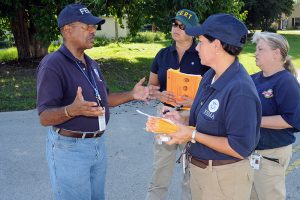In the 10 years between 2003-2012, natural disasters caused estimated global losses of more than $150 billion and the loss of more than 100,000 lives per year, according to the Center for Research on the Epidemiology of Disaster. Recovery from these disasters involves emergency management activities paid for by federal, state and local agencies and organizations.
For her project with the Coastal Resilience Center of Excellence (CRC), Dr. Sandra Knight treats that recovery and building of resilience as a large-scale project that can be approached through project management frameworks.

The project led by Dr. Knight, “Development and Testing of a Project Management Curriculum for Emergency Managers,” at the University of Maryland (UMD) focuses on developing a curriculum to improve project management skills in the emergency management community. Other participants in the project include John Cable and Dr. Allison Reilly of the Project Management Institute at UMD.
To better manage the escalating costs and complex demands of natural hazards, emergency managers, engineers and construction managers should integrate their skills to deliver projects and programs that are resilient in post-disaster environments, Dr. Knight said. The goal of the education project is to develop and test a curriculum that combines the challenges of emergency management with the capabilities and technologies introduced through project management processes.
The Multi-Hazard Mitigation Council has established that building resilience into the built, environmental and social systems helps mitigate financial losses by a factor of at least 4:1. While mitigating in advance of disasters is desirable, most funds are provided in a post-disaster environment – the Federal Emergency Management Agency’s (FEMA) disaster mitigation grants represent approximately 15 percent of the total disaster dollars, Dr. Knight said. Major investments are made through public assistance funds, U.S. Department of Housing and Urban Development Community Development Block Grants and supplemental appropriations for disaster response, clean-up and recovery.
“Managing the vast portfolio of disaster funds, which come from many disparate sources, is a daunting task that can be improved through proven organizational processes,” Dr. Knight said. “We live in an environment where the cost of disasters, particularly in coastal areas, is continually rising. By the year 2050, one report estimates that we’ll experience losses of $1 trillion a year in coastal areas.
“It is imperative, in this often-urgent post-disaster environment, that project and emergency managers have the right training and educational skills to effectively deliver projects on-time and on-budget while being considerate of the needs of the community and planning for a resilient future.”

Disasters create disruptive environments that require emergency managers to make critical decisions within limited time frames with often less-than-optimal resources, she said. These decisions include executing and managing projects and programs under volatile change management scenarios while people and communities are dealing with loss and confusion.
“By incorporating modern project management processes, technologies and skills, emergency managers will be able to manage and execute disaster-related projects and meet resilience goals more effectively and efficiently,” Dr. Knight said. “By building disaster-resilient concepts and emergency protocols into project management processes, project managers will be equipped to contribute to a more sustainable and disaster-resilient future.”
The project combines two distinct functions and career fields: Emergency management, which functions to protect communities and reduce vulnerabilities by mitigating and responding to hazards, and project management, the process of applying specific knowledge, skills, tools and techniques to meet project requirements. Project management tools include managing cost and schedules, preparing for change and mitigating project risks, maintaining quality assurance and quality control, while communicating expectations to those responsible for the projects and programs and those impacted by them.
Applying project management organizational processes and tools to emergency management, Dr. Knight said researchers hope to allow emergency managers to meet resilience goals more efficiently. By building disaster-resilience concepts and emergency protocols into project management, project managers will be better equipped to contribute to overall resilience.
Practitioners in emergency management and project managers who carry out emergency management activities will have the opportunity to hone their knowledge and skills through a set of courses that will be offered through the existing UMD Project Management Program. Curricula will be developed to support existing certifications for practitioners and both degree and non-degree programs at the University of Maryland. An introductory course, “Principles of Disaster Management,” was taught in the spring 2017 semester, with 11 students participating.
Managing the vast portfolio of disaster funds, which come from many disparate sources, is a daunting task that can be improved through proven organizational processes. We live in an environment where the cost of disasters, particularly in coastal areas, is continually rising.
Initial feedback was very positive, Dr. Knight said. Several students said that the experience made them more likely to pursue disaster-related fields, and scored highly the discussion of engineering solutions to societal issues.
UMD’s Center for Disaster Resilience will develop and test courses through coordination with the International Association of Emergency Management, FEMA coordinating offices and other potential Homeland Security partners. The project team will create targeted training materials and short-courses to provide the broadest access possible for practitioners.
While some emergency managers have experience in operating in fast-paced and disruptive environments, most do not have formal project management training, Knight said.
“When emergency managers, construction engineers and design engineers hit the ground post-disaster to recover and rebuild, it’s important that they do so smartly and effectively,” Dr. Knight said.
